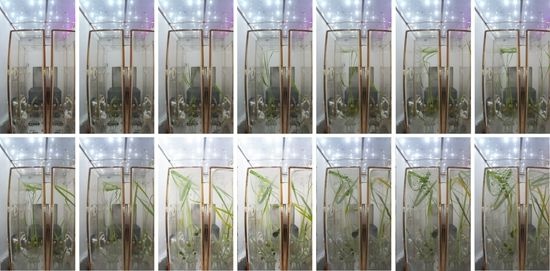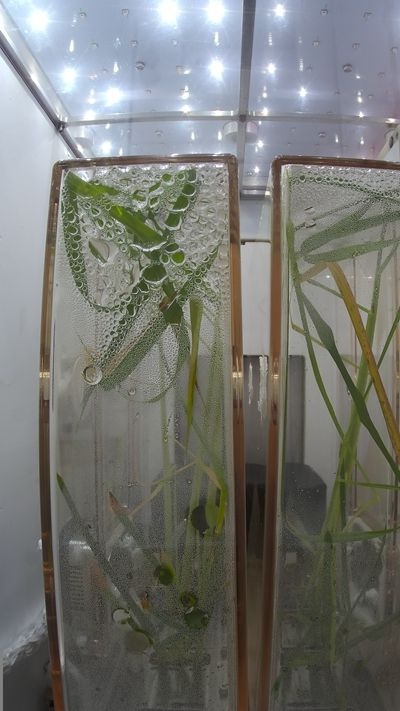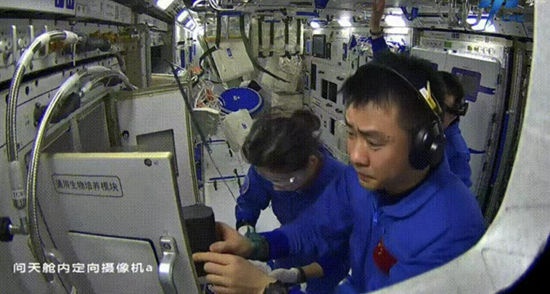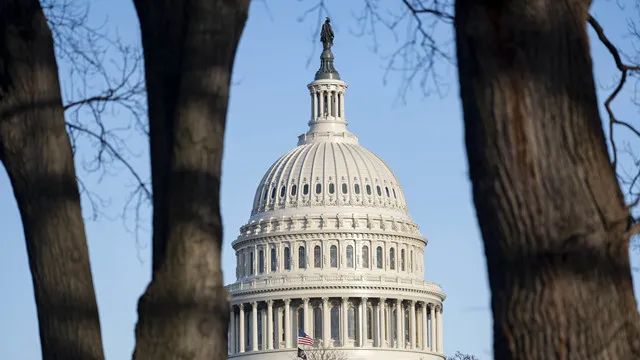The rice planted by China space station is "good in growth", about 30 cm high
Author:Changjiang Daily Time:2022.09.05
"The height of the box is 14 cm, exceeding (14 cm), and the high straw rice is now about 30 cm high!" On August 29, the rice planted by Zheng Huiqiong team in the Chinese Space Station successfully "full moon". At the press conference, she raised a box of boxes. Demonstrations with green rice seedlings explained to media reporters that they were even more exciting.
Zheng Huiqiong is a person in charge of the experimental project of the experimental project of the Chinese Academy of Sciences molecular plant science and excellence innovation center, and the Chinese space station asked about the "Molecular Mechanism of Higher Plants Flowing and Regulating Higher Plants under Microbial Gravity". In the past 20 years, her team has been committed to studying the growth of high plants in space. The progress of the inspection of the Cabin Cancai rice means that the Chinese are expected to cultivate the whole life cycle of "from seeds to seeds" in the international space station rice for the first time, and laid the foundation for human beings to eat rice in space in the future.
No matter where humans live, they must solve the problem of eating. On the earth, it is no longer a new term for food crisis. It has intensified under the influence of the new crown pneumonia's epidemic, geopolitics, and extreme climate; in space, it is obviously not a long -term plan to transport supply foods by rockets. In order to solve the problem of dinner, people are not only answering to the land and the ocean.
So, what kind of response did space give us?
The rice planted by China space station is "good growth state"
Since the launch of the first artificial earth satellite in the 1950s, how to use plants to ensure the food, oxygen and pure water required for human survival in the outside world, it has become one of the most concerned issues of space life science.
To survive space, planting crops is a must -solve problem. A scientist at the International Space Station and spacecraft's international space station and spacecraft have stated that it takes about $ 10,000 to send 1 pound (about 0.45 kg) food to the International Space Station. A senior research scientist from the Space Food System of Johnson Space Center from the National Aeronautics Aerospace Bureau also said in public that if the spacecraft starts a 5 -year Mars journey, each person needs to consume about 3,000 kilograms of food. These foods are obviously unsustainable if they are transported by rockets.
In other words, if the astronauts "break the jar and break" like Shen Teng's Duguyue and maintain their lives by eating inventory for a long time, "Lone Moon" may have come to an end.
Following the establishment of a farming civilization on the earth, humans have already opened up the posture of "getting over from the beginning" to the space. Especially in the past 10 years, with the return of the moon, landing in Mars, and establishing a moon or Mars base, it has become an important goal of human space exploration, and scientists in various countries are preparing for food for long -term survival in space. Zheng Huiqiong felt: "Solving the scientific issue of establishing a space life protection system is urgent."

Figures of the growth and development of rice under the condition of micro -gravity. Photo Conferry of Molecular Plant Science Innovation Center of Chinese Academy of Sciences
It is in this context that a series of space planting experiments such as rice station planting rice have emerged. On July 24, 2022, my country ’s space station asked the Tiangtian Experimental Cels to successfully launch and dock with the Tianhe Core Card. The Tianshi Experimental Cels were equipped with a scientific experimental cabinet such as the life ecological experimental cabinet and the biotechnology experimental cabinet. On July 28, the experimental unit containing experimental sample rice seeds was installed by a spaceman to the life ecological ecological experiment module that asked the sky experimental cabin, and the experiment was officially launched on July 29.
Zheng Huiqiong said that the goal of this experiment was to complete the cultivation research from the whole life cycle from seeds to seeds to the whole life cycle of the seed station in the world, explore the use of space environmental factors to control the flowering of plants to find the efficiency of plant production in small closed spaces in smaller closed spaces Maximize possible ways.
After the experiment was launched, the seeds of high stalks and short stalks were struggling to grow, but they did not expect that they encountered "water and water" in a micro -gravity space environment and suffered from "aerospace syndrome". The growing rice seedlings look a little "lazy", and they do not stand up like the rice on the ground. Instead, they stand on the wall of the transparent experimental box.
However, this does not affect the hope of successful experiments.
Zheng Huiqiong said that the seeds of rice have been successfully launched. The high-straw rice seedlings have grown to about 30 cm high, and the low-straw rice is also 5-6 cm high, and the growth state is good. After the seeds are successfully concluded in the future, the astronauts will collect samples and freeze to save, and finally return to the ground with the astronauts to analyze.
Humans have successfully harvested rapeseed, wheat, peas, etc.
In fact, space not only grows well -growing rice, but also brings a lot of surprises to humans.
Zheng Huiqiong introduced that in the past 60 years, scientists have conducted a lot of research on space planting and cultivation plants, and have conducted more than 20 plants and more than 50 space training experiments among various space aircraft.
Public information shows that in 1979, the Ritual No. 6 space station has begun to cultivate the sphere of onion and orchids, and conduct research on the growth and development of nanda, peas, and wheat.
In 1982, Arabia mustard was planted in the greenhouse of the Ritual Artillery No. 7 Space Station, and for the first time, it realized the space planting from seeds to seeds. Arabia is a representative of Gemini, long days, and cross flower plants. Many vegetables, such as vegetables, rapeseeds, etc., belong to the family of Cross Flowers, so this progress is of great significance to planting vegetables.
In 1997, "Super Washea" completed the experiment from seeds to seeds for the first time in Heping Space Station. The "staple food" of human space's survival was a great prince. With the advancement of science and technology, the "brain holes" of scientists are getting bigger and bigger.
In 2006, Zheng Huiqiong's team observed the flowering process of green vegetables on the "Practice No. 8" satellite in my country. In 2012, US astronaut Tang Pette opened a blog called "Space Sturgeon Diary", telling the process of growing up a zucchini at the International Space Station. Subsequently, the International Space Station launched a vegetable planting experiment in 2014. The lettuce harvested in 2015 also allowed astronauts to conduct a trial. In 2016, a gorgeous hundred -day chrysanthemum bloomed at the International Space Station. As the first ornamental flower cultivated by humans outside the earth, it not only deserves to be a "flower kui" in space, but also made the plants' space flowering research. Small contribution. In 2021, Chilean peppers blossomed in the "Higher Botanical Habitat" culture training device of the International Space Station and became the "side dishes" of astronauts.
The growth and development of rice under micro -gravity conditions. Photo Conferry of Molecular Plant Science Innovation Center of Chinese Academy of Sciences

Zheng Huiqiong said that the main goal of people's space plant training experiments in the early days was how to support plants in the space environment so that they could germinate, grow, flowers, and produce seeds. Now these goals have been achieved one by one. Some basic spatial plant biological problems, such as the growth of plants, the formation of roots, germination, seed components, changes in the expression of genes and protein, etc., have also been studied in depth in this process.
At present, the research of scientists has gradually expanded from the research on plant seedlings to seed production research. However, only a few crops of rapeseed, wheat and peas have completed the experiment from seeds to seeds in space to seeds. At the same time, under the conditions of space, problems such as delayed flowering time, low number of flowers, low seeds of seeds, and decreased seed quality are still not overcome. Therefore, this time the rice cabin's rice and other related experiments are mainly committed to studying the molecular mechanism of flowering regulation.
"Space Taste" flys into the home of ordinary people
Space planting is just a corner of space agriculture. Scientists are looking forward to using space resources to solve the problem of eating on the earth. The use of space and environment breeding to improve the variety of earth crops is also an important idea.
Why do you favor aerospace breeding? With the improvement of people's living standards, full food has long been able to meet the needs of ordinary people. Disaddous, health and other standards have made people's demand for new agricultural varieties more urgent. In addition, the social and natural environment is changing Factors have continuously put forward new requirements for crop species. Guo Tao, deputy director of the National Plant Aerospace Breeding Engineering Technology Research Center and professor of South China Agricultural University, believes that aerospace breeding combined with modern biology is one of the important means to ensure the safety of the national seed industry.
Astronauts operate scientific experimental cabinets in orbit. Chinese manned aerospace engineering office picture

Guo Tao said that scientists sent the earth seeds to space through the aircraft, and used the conditions such as high vacuum, micro -gravity, and space rays to induce their genetic genes to change, return to the ground, and then find ways to "fix" those good changes, so as Improve the specific traits of crop species.
In this way, the ninth returning satellite in my country in 1987 was equipped with more than 100 varieties of crop seeds such as wheat, rice, and green peppers, and successfully completed the first space breeding "space journey" in my country. Subsequently, the experiments related to aerospace breeding became richer, and vegetables, fruits, flowers, Chinese herbal medicines, etc. are all listed.
After more than 30 years of practice, the results of aerospace breeding are endless. In my country, more than 1,200 new materials have been screened through aerospace breeding, and more than 260 new varieties have been cultivated, with an annual promotion area of tens of millions of acres. Many scientific research results have been moved from laboratory to ordinary people's tables.
Guo Tao introduced that my country has achieved the industrialization of aerospace breeds such as rice, wheat and other crops in the 1990s, and then related industries have continued to grow and grow.
Take Guo Tao's research team as an example. For more than 10 years, the team has selected 57 new rice varieties that have been promoted and applied in production, and the promotion area has accumulated more than 50 million mu. Guo Tao said: "For example, after China Airlines No. 31 rice is mutated by space, the output has increased by about 10%, becoming the leading variety of agricultural leaders in Guangdong Province." Previously, some experts told the media that about 30%of the Beijing markets were "aerospace strawberry".
In fact, human beings' use of space resources to enrich the earth table is not limited to aerospace breeding.
Some experts have proposed that in the future, the biological synthetic factory may be used in space construction, and unique conditions such as micro -gravity and high vacuum can be used to complete the high -efficiency synthesis of large molecular compounds or specific proteins. "Meat" high -value agricultural products.
It is not difficult to see that no matter where you survive, the plan and execution of human beings rely on the "sky" to eat are quite good. Human beings want to be multi -planet species, probably not extravagant hopes. (Reporter Zhang Qian)
(Source: Xinhua News Agency client)
【Edit: Fu Sakura】
For more exciting content, please download the "Da Wuhan" client in the major application markets.
- END -
Who is the popular candidate for the next election in the United States?

07.07.2022Number of this text: 1120, reading time for about 2 minutesGuide: The la...
Scotland plans to hold a new independent referendum on October 19, 2023

Jimu Journalist Song QingyingAccording to BBC reports on June 28, the Chief Minist...